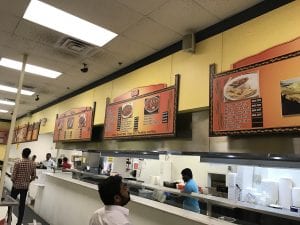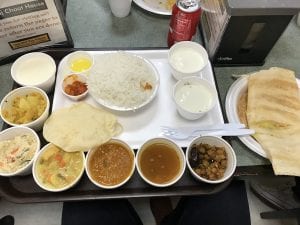Walking through the Taj Grocers in Plano, Texas is as close as you can get to a cultural vacation while remaining within 30 minutes of the SMU campus.
Upon entering the grocery store, I was immediately overwhelmed by the aroma of the store. Describing the smell is difficult; however, it was a mix of spices, grains, and fresh vegetables that when combined together, produce an intensely unique aroma. The scent itself was a sensory overload. As I began to wander the aisles, looking at unfamiliar products and goods I did not recognize, I realized that I was no longer in Plano and was actually in a pocket of Indian culture.
Indian grocers have a strong affective quality. As such, the stores present an emotional experience that you do not find at your local Kroger. Along the walls of the store are sculptures and pieces of furniture featuring Brahma, Vishnu, and Shiva – some selling for as little as twenty dollars and some for well over a couple hundred dollars. By design, the store served a larger purpose than just an Indian grocer. Purnima Mankekar accounts this in, Unsettling India: Affect, Temporality, Transnationality (2015), that “Indian grocery stores are implicate in processes of place making…that migrants and diasporic subjects produce culturally defined sensuous geographies” (Mankekar). Considering the strong history in India of maintaining a strict and unique diet, eating traditional foods is important to the people of India. Between the store’s surplus of fifty-pound bags of lentils and beans, to the stores array of spices, the history of Indian diet was laced throughout each aisle. Displaced Indian grocery stores serve not only as a reminder for its locals of their rich Indian history, but also as an opportunity for someone like me (with little to no previous knowledge of Indian culture and history) to learn what it might feel like to be in India.
The back of the Taj Grocers store is the Taj Chaat House, a restaurant that offers a wide array of traditional dishes. The menu, although completely foreign to me, was filled with pictures and descriptions of what the different dishes were. I ordered the Madras Thali, which was a combination platter with a dosa, rice, semiya soup, subjis curries, and a yogurt. Although I found each item unique and delicious in its own way, I found the dosa to be the most unique. The dosa was a large crepe made with lentils and rice. The dosa allowed me to combine different smaller dishes on my platter and combine them in the dosa. I found this to be the best, and easiest, way try the assortment.
In the future, and when I visit more cultural grocery stores, I plan to again imagine myself in a different country to fully enjoy the cultural experience the store will offer me.
Mankekar, Purnima. Unsettling India: Affect, Temporality, Transnationality. Durham: Duke University Press, 2015. 13-26.



